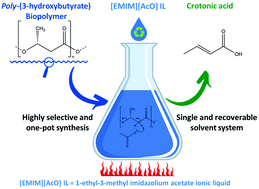Sustainable, highly selective, and metal-free thermal depolymerization of poly-(3-hydroxybutyrate) to crotonic acid in recoverable ionic liquids†
Abstract
Valorization of renewable and biodegradable biopolymers to value added chemicals and green fuels is currently considered as an important research topic aiming at reducing the dependency on fossil derived feedstocks as well as their negative consequences on the environment. In this report, we are introducing an ionic liquid (IL) mediated, sustainable, and green synthesis of crotonic acid (CA) from poly-(3-hydroxybutyrate, PHB), a biopolymer derived from microbial fermentation. In this actual case, imidazolium cation comprising ILs have been used in the synthesis, where the influence of various reaction parameters such as reaction temperature and types of ILs as well as the amount of polymer, water, and IL in the reaction mixture were examined. The conversion of PHB to CA in IL took place by a base catalyzed depolymerization with formation of crotonyl terminated polymeric entities as intermediates, a mechanism that was confirmed by NMR analysis of the reaction mixtures sampled when the reactions were carried out at various temperatures. The rate of CA formation via the IL mediated base catalyzed depolymerization increased with increasing temperature in the tested interval, and 97% yield of CA was obtained after 90 min at 140 °C. The [EMIM][AcO] IL applied as solvent and catalyst is capable of completely depolymerizing PHB to CA in 5 h at 120 °C up to a polymer loading of 40 wt%. At higher loadings the depolymerization became incomplete, which is attributed to a deactivation of the IL due to hydrogen bonding interactions with the in situ formed CA, confirmed by NMR and DSC techniques. Since the depolymerization is base catalyzed, the only tested ILs that were able to form CA were based on acetate anions, whereas the less basic or neutral [EMIM][Cl] IL was found to be inactive. Finally, more than 90% of CA as well as [EMIM][AcO] IL were recovered in high purity by solvent extraction with brine (saturated aqueous NaCl) and 2-methyl tetrahydrofuran (2-Me-THF). Most importantly, here we introduce a sustainable, metal free, and single solvent based reaction approach for selective depolymerization of PHB to industrially valuable CA in basic and recoverable ILs.



 Please wait while we load your content...
Please wait while we load your content...